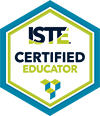

Event Information
Times are Approximate
This session is designed for peers to collaborate in various content areas to create authentic, engaging assessments. Interactive discussion and tools will be included in each section. A graphic organizer (both digital and hard copy) is provided for participants to keep track of the work and process they do.
I. Intro - About the Presenter, and Interactive Tech Tool - What Makes for Effective Classroom Assessment - 5 Minutes
II. Using Generative AI as a Collaboration Partner in Assessment Design - Provides an Overview to the process - 5 Minutes
III. Step 1: Unpacking Standards - Set Up as an I Do, You Do, approach, participants in small groups will interact with various generative AI tools to unpack a group of standards in small groups or in pairs - 15
IV. Step 2: Creating Aligned Questions Aligned to Depth
We will do a digital sort on DOK and digital share out; then will explore how to use generative AI to create similar questions aligned to standards in step 1 - 15 Minutes
VI. Step 3: Providing Feedback & Adjustments - Participants will learn how to use generative AI to provide student feedback. They will then use their generative ai tool to create an extension/intervention to support student learning - 10
V. Conclusion - Square/Triangle/Arrow Reflection - 5 Minutes
The presenter will interact with the audience through PearDeck as well as through floating from group to group as they work through the 1-2-3 process.
Drost, B. & Shryock, C. (2025-in press). Using Generative AI for Instructional Design. In N. K. Ulutas (Ed), Reimagining Intelligent Computer Assisted instruction. IGI Global.
Darling-Hammond L., Banks J., Zumwalt K., Gomez L., Gamoran Sherin M., Griesdorn J., Finn L. (2005). Educational goals and purposes: Developing a curricular vision for teaching. In Darling-Hammond L., Bransford J. (Eds.), Preparing teachers for a changing world: What teachers should learn and be able to do (pp. 169–200). Jossey-Bass.
DeLuca C., Bellara A. (2013). The current state of assessment education: Aligning policy, standards, and teacher education curriculum. Journal of Teacher Education, 64(4), 356–372.
DeLuca C., Chavez T., Bellara A., Cao C. (2013). Pedagogies for preservice assessment education: Supporting teacher candidates’ assessment literacy development. The Teacher Educator, 48, 128–142.
Drost, B,. & Levine, A. (2015). An Analysis of Strategies for Teaching Standards-Based Lesson Plan Alignment to Preservice Teachers. Journal of Education, 195(2). https://DOI:10.1177/002205741519500206
Drost, B. & Levine, A. (2023). An analysis of strategies for teaching and assessing standards-based assessment design to preservice teachers. Journal of Education, 203(3). https://doi.org/10.1177/00220574211038711
Francis, E. (2016). Now that’s a good question: How to promote cognitive rigor through classroom questioning. ASCD.
Knips, A., Lopez, S., Savoy, M., & Laparo, K. (2023) Equity in data: A framework for what counts in schools.
OpenAI. (2024).
ChatGPT (GPT-4). [Large language model]. https://chatgpt.com
Popham, W. J. (2020). Classroom assessment: What teachers need to know (9th ed.). Pearson.
Schmoker, M. (2018). Focus: Elevating the essentials to radically improve student learning (2nd ed.). ASCD.
Schmoker, M. (2023). Results now 2.0: Untapped opportunities for swift, dramatic gains in achievement. ASCD.
Stiggins R. J., Conklin N. F. (1992). In teachers’ hands: Investigating the practices of classroom assessment. State University of New York Press.
Wiliam, D., Fisher, D., & Frey, N. (2024). Student Assessment. Corwin.
ASCD is focusing an entire Educational Leadership this fall on using generative AI in schools. I have an article submitted to this publication on this very topic.

